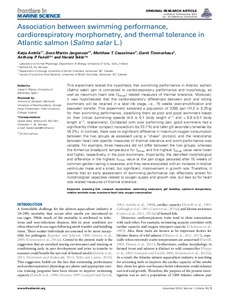Association between swimming performance, cardiorespiratory morphometry, and thermal tolerance in Atlantic salmon (Salmo salar L.)
Katja Anttila; Sven Martin Jørgensen; Matthew T. Casselman; Gerrit Timmerhaus; Anthony P. Farrell; Harald Takle
https://urn.fi/URN:NBN:fi-fe2021042715451
Tiivistelmä
This experiment tested the hypothesis that swimming performance in Atlantic salmon (Salmo salar) parr is connected to cardiorespiratory performance and morphology, as well as maximum heart rate (fHmax) related measures of thermal tolerance. Moreover, it was hypothesized that the cardiorespiratory differences between poor and strong swimmers will be retained in a later life stage, i.e., 15 weeks post-smoltification and seawater transfer. This experiment screened a population of 3200 parr (11.2 ± 0.25 g) for their swimming performance, classifying them as poor and good swimmers based on their critical swimming speeds (4.4 ± 0.1 body length s−1 and > 6.8 ± 0.1 body length s−1, respectively). Compared with poor performing parr, good swimmers had a significantly thicker compact myocardium (by 23.7%) and taller gill secondary lamellae (by 16.2%). In contrast, there was no significant difference in maximum oxygen consumption between the two groups as assessed using a “chase” protocol, and the relationship between heart rate specific measures of thermal tolerance and swim performance was variable. For example, three measures did not differ between the two groups, whereas the Arrhenius breakpoint temperature for fHmax and the highest fHmax value were lower and higher, respectively, in the poor swimmers. Importantly, the identified morphological and difference in the highest fHmax value at the parr stage persisted after 15 weeks of common garden rearing in seawater, and they were associated with an increase in relative ventricular mass and a small, but significant, improvement in growth rate. Therefore, it seems that an early assessment of swimming performance can effectively screen for morphological capacities related to oxygen supply and growth rate, but less so for heart rate related measures of thermal tolerance.
Kokoelmat
- Rinnakkaistallenteet [27094]
